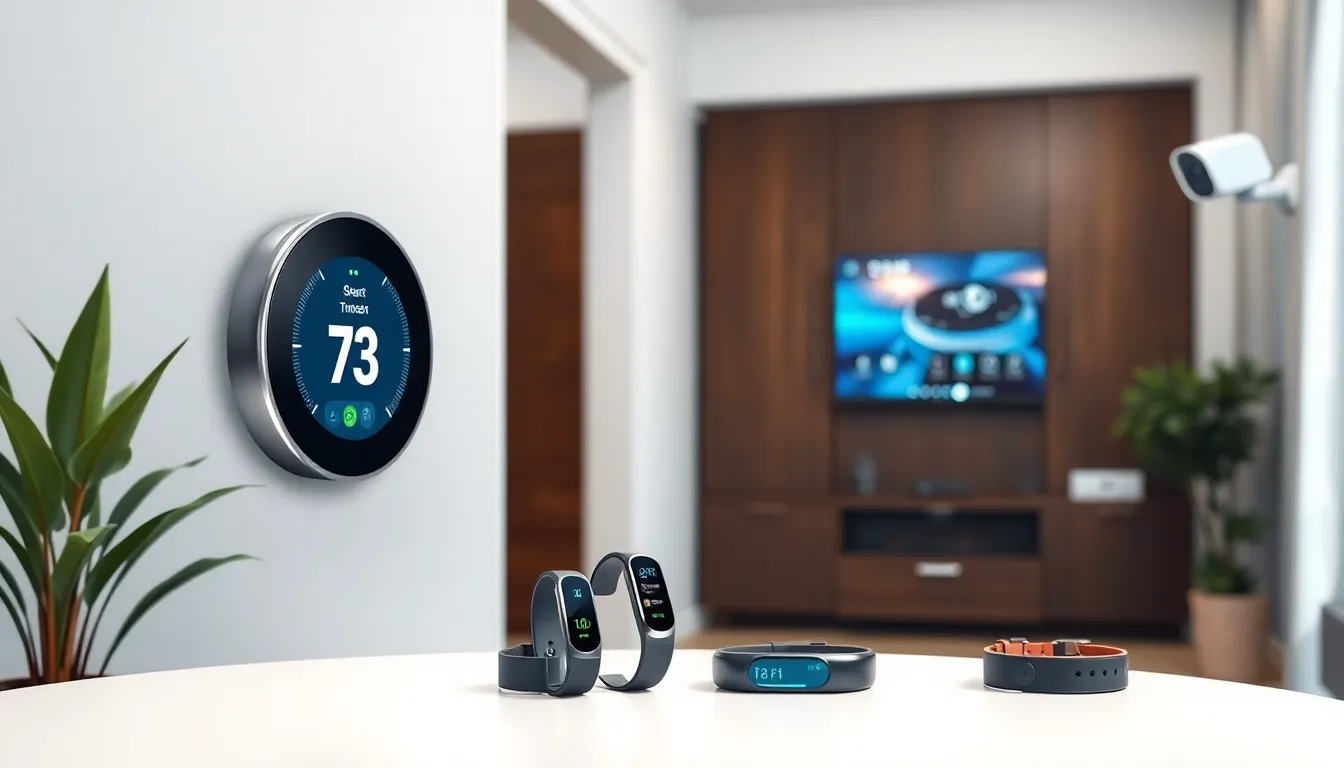Table of Contents
ToggleIn a world where your fridge can remind you to buy milk and your thermostat knows when you’re too hot to handle, the Internet of Things (IoT) is here to revolutionize daily life. Imagine a universe where everyday objects chat with each other, making your life smoother than a buttered slide. Sounds like science fiction? It’s not—it’s reality, and it’s happening right now.
The Internet of Things connects devices, allowing them to share data and make intelligent decisions. From smart homes to wearable tech, IoT is transforming how people interact with their environment. So buckle up because this tech rollercoaster is just getting started, and understanding its definition is your first step toward becoming a savvy participant in this digital revolution.
Internet of Things Definition
The Internet of Things (IoT) refers to the network of interconnected devices capable of collecting, exchanging, and analyzing data through the internet. This technology allows everyday objects to communicate and utilize intelligence to improve efficiency in various settings.
Overview of the Concept
IoT connects devices, enabling them to share information in real-time. Smart appliances, wearables, and environmental sensors exemplify devices embedded with IoT technology. These connections lead to smarter systems that optimize performance and functionality. Enhanced automation simplifies daily tasks, resulting in improved quality of life. Businesses leverage IoT for insights into operations, enabling data-driven decision-making and increased productivity.
Historical Context
The development of IoT has roots in the early 1980s, when the first internet-connected toaster was created. Researchers recognized the potential for appliances to communicate and share data. In 1999, Kevin Ashton coined the term “Internet of Things,” defining the concept of linking physical objects to the internet. However, the rapid advancement of wireless technology and cloud computing in the 2000s accelerated IoT growth. Companies began adopting IoT solutions, driving innovation and shaping industries through interconnectivity.
Key Components of IoT

Key components of the Internet of Things (IoT) include devices, connectivity, and data processing. These elements work together to create a seamless network of communication and automation.
Devices and Sensors
Devices and sensors serve as the foundation of IoT. They gather data from their environment, including temperature, humidity, and movement. Common examples of these devices include smart thermostats, fitness trackers, and security cameras. Sensors play a crucial role in monitoring conditions and sending alerts to users, enhancing overall efficiency. In smart homes, these devices automate many tasks, improving convenience and energy management.
Connectivity
Connectivity connects IoT devices to the internet and each other. Various communication protocols, such as Wi-Fi, Bluetooth, and cellular networks, facilitate this interaction. Reliable connectivity enables real-time data exchange, ensuring devices function cohesively. Without strong connections, the performance and reliability of IoT systems suffer. Users benefit from seamless experiences, including remote control over devices and instant updates on system statuses.
Data Processing
Data processing transforms raw data into useful insights. Cloud computing platforms and edge computing play vital roles in handling this information efficiently. By analyzing data, IoT systems can identify patterns, predict outcomes, and optimize device performance. Real-time analytics allow for timely actions, such as adjusting energy consumption or alerting users to unusual activity. Effective data processing enhances decision-making and overall system effectiveness in various applications.
Applications of IoT
IoT technology integrates into various sectors, enhancing functionality and efficiency. These applications span smart homes, industrial settings, and healthcare innovations.
Smart Homes
Smart homes leverage IoT devices for improved convenience and energy efficiency. Appliances connect to the internet, allowing users to control them remotely via smartphones or voice assistants. For instance, smart thermostats optimize energy usage while ensuring comfort through automated temperature adjustments. Home security systems also benefit from IoT; they allow real-time monitoring and alerts for suspicious activity. By utilizing smart technology, homeowners enjoy increased control over their living environment, leading to enhanced quality of life.
Industrial IoT
Industrial IoT transforms manufacturing and supply chain management. Connected machinery collects real-time data, enabling predictive maintenance that reduces downtime and operational costs. Factories implement IoT sensors to monitor equipment performance, leading to enhanced production efficiency. Inventory management improves through automated tracking of goods, minimizing waste and ensuring timely replenishment. With reliable data analysis, industries can optimize processes and drive innovation, contributing to competitive advantages in the market.
Healthcare Innovations
In healthcare, IoT applications enhance patient care and operational efficiency. Wearable health devices track vital signs, allowing continuous monitoring and quicker response times. Telemedicine solutions utilize IoT for remote patient consultations, increasing accessibility for individuals in rural areas. Hospitals deploy smart systems for inventory management, ensuring timely supplies and reducing costs. By harnessing IoT technology, healthcare providers improve patient outcomes and streamline operations, showcasing its significant impact on the industry.
Challenges and Considerations
IoT presents several challenges that require careful examination to ensure its safe and effective deployment. Key issues include security and data privacy, both vital for user trust and long-term success.
Security Concerns
Security concerns pose significant risks in IoT ecosystems. Hackers target connected devices, potentially breaching personal spaces or corporate networks. Vulnerabilities in devices, like weak passwords or outdated firmware, create entry points for malicious activities. Protecting sensitive data becomes critical, as compromised devices can lead to unauthorized access. Strategies like end-to-end encryption and regular software updates enhance device security. Ensuring that manufacturers follow best practices in security design can reduce potential risks associated with IoT.
Data Privacy Issues
Data privacy issues arise when IoT devices collect and share personal information. Consumers often unknowingly provide vast amounts of data, raising concerns about its use and storage. Regulators impose stricter privacy laws to protect user data, highlighting the need for transparency in data handling. Users expect clarity on what data is collected and how it is used. It’s essential for companies to implement robust privacy policies and give users control over their data. Addressing these privacy concerns fosters trust and encourages broader adoption of IoT technologies.
The Internet of Things is reshaping how people interact with technology and their environment. As devices become smarter and more interconnected, they offer unprecedented convenience and efficiency. The potential applications span various industries from smart homes to healthcare, driving innovation and improving daily life.
However, as IoT continues to evolve, addressing security and data privacy challenges is essential. Ensuring that users feel safe and informed about their data will play a crucial role in the widespread adoption of IoT technologies. Embracing these advancements while prioritizing user trust will pave the way for a more connected and intelligent future.







